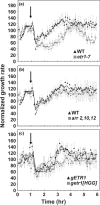A role for two-component signaling elements in the Arabidopsis growth recovery response to ethylene
- PMID: 31245724
- PMCID: PMC6508545
- DOI: 10.1002/pld3.58
A role for two-component signaling elements in the Arabidopsis growth recovery response to ethylene
Abstract
Previous studies indicate that the ability of Arabidopsis seedlings to recover normal growth following an ethylene treatment involves histidine kinase activity of the ethylene receptors. As histidine kinases can function as inputs for a two-component signaling system, we examined loss-of-function mutants involving two-component signaling elements. We find that mutants of phosphotransfer proteins and type-B response regulators exhibit a defect in their ethylene growth recovery response similar to that found with the loss-of-function ethylene receptor mutant etr1-7. The ability of two-component signaling elements to regulate the growth recovery response to ethylene functions independently from their well-characterized role in cytokinin signaling, based on the analysis of cytokinin receptor mutants as well as following chemical inhibition of cytokinin biosynthesis. Histidine kinase activity of the receptor ETR1 also facilitates growth recovery in the ethylene hypersensitive response, which is characterized by a transient decrease in growth rate when seedlings are treated continuously with a low dose of ethylene; however, this response was found to operate independently of the type-B response regulators. These results indicate that histidine kinase activity of the ethylene receptor ETR1 performs two independent functions: (a) regulating the growth recovery to ethylene through a two-component signaling system involving phosphotransfer proteins and type-B response regulators and (b) regulating the hypersensitive response to ethylene in a type-B response regulator independent manner.
Keywords: Arabidopsis; ethylene; histidine kinase; phosphotransfer protein; receptor; response regulator.
Figures





Similar articles
-
Ethylene-Stimulated Nutations Do Not Require ETR1 Receptor Histidine Kinase Activity.Plant Signal Behav. 2006 Nov;1(6):287-9. doi: 10.4161/psb.1.6.3585. Plant Signal Behav. 2006. PMID: 19704568 Free PMC article.
-
Ethylene receptor ETHYLENE RECEPTOR1 domain requirements for ethylene responses in Arabidopsis seedlings.Plant Physiol. 2011 May;156(1):417-29. doi: 10.1104/pp.110.170621. Epub 2011 Mar 8. Plant Physiol. 2011. PMID: 21386032 Free PMC article.
-
Arabidopsis seedling growth response and recovery to ethylene. A kinetic analysis.Plant Physiol. 2004 Oct;136(2):2913-20. doi: 10.1104/pp.104.050369. Epub 2004 Oct 1. Plant Physiol. 2004. PMID: 15466220 Free PMC article.
-
Plant histidine kinases: an emerging picture of two-component signal transduction in hormone and environmental responses.Sci STKE. 2001 Nov 20;2001(109):re18. doi: 10.1126/stke.2001.109.re18. Sci STKE. 2001. PMID: 11717470 Review.
-
Ethylene and cytokinin signalling in plants: the role of two-component systems.Essays Biochem. 1997;32:101-11. Essays Biochem. 1997. PMID: 9493014 Review.
Cited by
-
Non-Canonical Inter-Protein Interactions of Key Proteins Belonging to Cytokinin Signaling Pathways.Plants (Basel). 2025 May 15;14(10):1485. doi: 10.3390/plants14101485. Plants (Basel). 2025. PMID: 40431050 Free PMC article. Review.
-
SlATG8f coordinates ethylene signaling and chloroplast turnover to drive tomato fruit ripening.Plant Cell Rep. 2025 Aug 22;44(9):200. doi: 10.1007/s00299-025-03578-8. Plant Cell Rep. 2025. PMID: 40846794
-
Verticillium wilt resistant and susceptible olive cultivars express a very different basal set of genes in roots.BMC Genomics. 2021 Apr 1;22(1):229. doi: 10.1186/s12864-021-07545-x. BMC Genomics. 2021. PMID: 33794765 Free PMC article.
-
Ectopic expression of GmHP08 enhances resistance of transgenic Arabidopsis toward drought stress.Plant Cell Rep. 2021 May;40(5):819-834. doi: 10.1007/s00299-021-02677-6. Epub 2021 Mar 16. Plant Cell Rep. 2021. PMID: 33725150
-
Phosphorylation Site Motifs in Plant Protein Kinases and Their Substrates.Methods Mol Biol. 2021;2358:1-16. doi: 10.1007/978-1-0716-1625-3_1. Methods Mol Biol. 2021. PMID: 34270043 Review.
References
-
- Binder, B. M. , Chang, C. , & Schaller, G. E. (2012). Perception of ethylene by plants: Ethylene receptors In McManus M. T. (Ed.), Annual plant reviews: The plant hormone ethylene, Vol 44 (pp. 117–145). Hoboken, NJ: Wiley‐Blackwell; 10.1002/9781118223086.ch5 - DOI
LinkOut - more resources
Full Text Sources
Molecular Biology Databases
Research Materials

